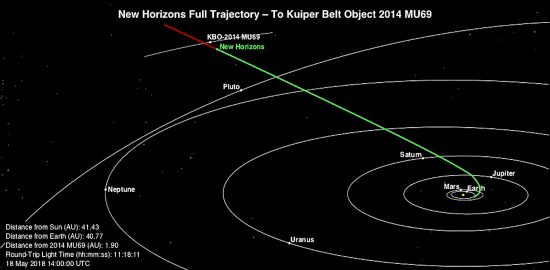May 18, 2018
The most distant encounter with a Solar System object will take place on New Year’s Day 2019.
“To infinity and beyond!”
— Buzz Lightyear
NASA launched the New Horizons spacecraft on January 19, 2006 on a mission to explore the outer Solar System, including Pluto, Charon and many Kuiper Belt Objects.
Pluto was discovered on February 18, 1930 by Clyde W. Tombaugh. The astronomer, Percival Lowell, thought there ought to be another planet, or large asteroid, past the orbit of Neptune, because there was an anomalous influence on their orbital calculations. Following Urbain Le Verrier’s prediction about the existence of Neptune, Lowell assumed that “Planet X” was there, although he never found it. After Tombaugh’s discovery, an 11-year-old girl named Venetia Burney suggested that Planet X be called “Pluto” after the Roman god of the dead.
Pluto is in a highly eccentric orbit. Aphelion is 7.3 billion kilometers from the Sun, while perihelion brings it no closer than 4.4 billion kilometers. One revolution takes about 248 years, longer than the existence of telescopes that can see it. The last time Pluto was in the same place in its orbit as it is now was six years before the American Revolutionary war in 1776.
On July 14, 2015 New Horizons flew by the dwarf planet at a distance of 9656 kilometers. Although it has been three years since the encounter with Pluto, its geology continues to pose “mysteries” and “processes that have yet to be understood.” Complex chains of craters and melted pits extend outward from terraced depressions. Flat bottoms and vertical sidewalls are signs of electric discharge machining. Indeed, the indications are that electrically active phenomena sculpted Pluto’s surface.
As previously written, Pluto resembles its sister moons and dwarf planets. There are areas where ripples and “cantaloupe” terrain dominate. There are steep-walled craters with flat floors, hexagons, thousand-kilometer trenches, hectares of pits, craters on the rims of other craters, and other features that mark Pluto as an electrically devastated world. However, that devastation took place sometime in the past, leaving Pluto a blasted, frozen hulk.
There is little electrical connection between Pluto and the Sun because Pluto has no magnetosphere, so no shield between it and solar wind ions. Similar to other rocky planet-sized bodies, it sports a long tail composed of heavier, ionized atmospheric gases―primarily methane, with a “thin” magnetopause. The so-called “Plutopause” is the boundary region between solar plasma and Pluto’s feeble electromagnetic field, so its equipotential surface is small.
According to a recent press release, New Horizons is less than 8 months away from an historic flyby of Kuiper Belt Object (KBO), 2014 MU69, scheduled to occur on January 1, 2019. That means it will be the farthest encounter with any celestial body, almost two billion kilometers beyond Pluto.
The Kuiper Belt theory is the creation of astronomer Kenneth Edgeworth from Ireland and also separately by American astronomer Gerard Kuiper. Sometimes known as “trans-Neptunian Objects”, the first KBO was discovered in 1992.
Eris is the largest KBO, approximately 5% larger than Pluto, and is located 1.4 trillion kilometers from the Sun. Eris has its own small moon called Dysnomia. Quaoar is about 6 billion kilometers from the Sun and revolves in the region of the Kuiper Belt beyond Pluto’s orbit. Quaoar is the third largest KBO, half the size of Pluto and about as large as Pluto’s moon Charon. The fourth largest KBO yet discovered is Varuna, about 40% as large as Pluto.
There is a kink in the order and arrangement of the KBOs. An object called Sedna was discovered in an orbit that is much farther out than the grouping that includes Eris, Quaoar and Varuna. Sedna is large, about as big as Pluto, but it reaches more than 1 trillion kilometers from the Sun in an eccentric orbit, making it too far away to technically be considered a KBO. The theory has yet to accommodate Sedna.
2014 MU69 is not a large object. It is about 30 kilometers in diameter, but its shape is irregular. New Horizons will be about 3500 kilometers from 2014 MU69 during its flyby, so some high resolution images are expected to be received sometime in June 2019. As with the Pluto encounter, Electric Universe advocates expect that new data will provide additional confirmation of the theory’s premise: electrical sculpting of planets and moons.
Stephen Smith













